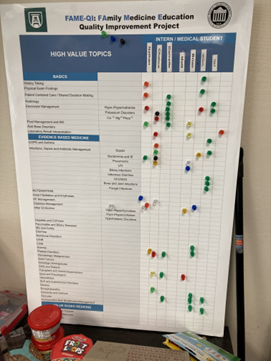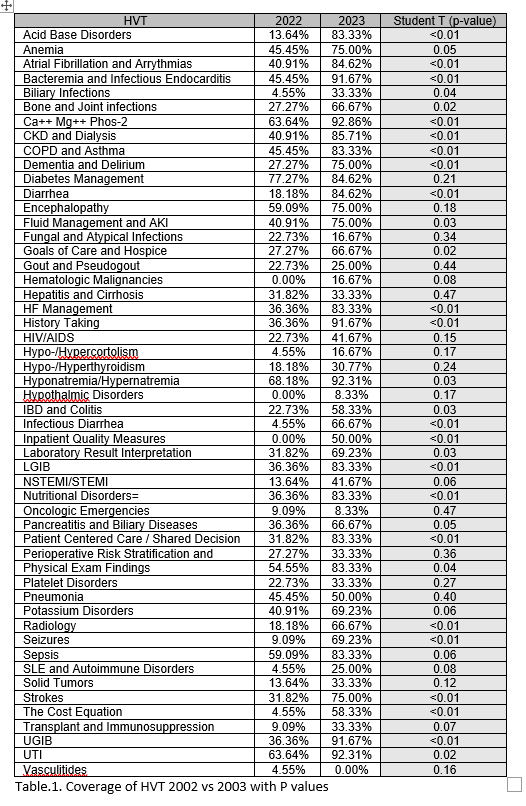Background: The Hospitalist Service of Wellstar-MCG Health run the Family Medicine In-Service (FMIS) rotations. It is a month-long rotation with a team consisting of a hospitalist attending, one or two senior residents, and several interns. A large portion of learning to care for inpatients occurs during these rotations. There currently is no process in place to track what is taught during the month. The hospitalists work on an alternating week on week off schedule making coordination of teaching difficult. We undertook this project to develop a process to both track teaching and improve coordination of teaching on the FMIS rotations over a two-year period (2022-2024). We are presenting interim data for the first quarter of 2023.
Methods: The hospitalist attendings and senior residents were considered the teachers, while the interns the learners. High Value Topics (HVTs) were identified based on the Family Medicine core curriculum and tabulated on a magnetic whiteboard (see Figure.1). The project was introduced to the Family Medicine interns and residents during a noon conference at the start of the academic year (2022). The interns were tasked to mark, on the whiteboard, HVTs that were actively discussed either by the supervising attendings or senior residents during the rotation. The data and whiteboard were updated monthly. The first year of data collection (2022) was targeted at establishing a baseline i.e. the percentage of interns indicating that a certain HVT was covered during the month. A survey by interns and residents on ease and acceptability of the process was favorable to continuing the project. We incorporated the introduction of the project objectives into the orientation of the incoming interns (2023). This year the FMIS expanded to two teams Family A/B. Data was presented to the hospitalist service during a monthly staff meeting and the staff were encouraged start exploring ways to use the whiteboard to coordinate teaching and to cover as many of the HVTs during the month. Statistical analysis was done with a single tailed Student-T test for each HVT.We defined two metrics: HVT Coverage = Number of Interns marking the HVTs as having been discussed x 100 Number of Interns in the block for the rotationPercentage (%) of Curriculum = Number of HVTs discussed during the month x100 Total number of HVTs (52)
Results: There was wide range of HVT coverage during 2022 ranging from not covering Inpatient Quality Measures (0%) to teaching Hypo/Hypernatremia a majority (68.1%) of the time. We were able to significantly impact coverage of most HVTs in the first quarter of 2023 i.e. Hypo/Hypernatremia teaching went up to 92.3% (P< 0.03) (See Table.1.) We continue to challenge our colleagues to find novel interventions or techniques to improve coverage of the HVTs. Subsequently, the % of Curriculum taught improved from 28.76% in 2022 to 59.46% in 2023 (P< 0.01). This data can be used to create report cards to help define individual learning plans (ILPs) for the interns. In the future we will correlate HVT data with more objective measures of learning like the In-Training Examinations (ITEs). Initial feedback by interns suggests no added burden to their current responsibilities.
Conclusions: We have created a viable, unobtrusive, cost neutral, and easily reproducible process for tracking intern’s perception of teaching by hospitalist attendings and senior residents on the FMIS monthly rotations.


